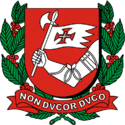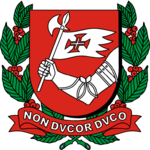User:Ferwsn/sandbox1
| Premier of Belmonte | |
|---|---|
| Premiê de Belmonte (Luzelese) | |
| Style | Excellency |
| Reports to | President and Congress |
| Residence | Bensafrim House |
| Seat | Castelonovo |
| Nominator | Political parties |
| Appointer | President |
| Term length | No term limits As long as the premier has parliamentary support |
| Formation | 18 October 1836 |
| First holder | Augusto Cintra |
| Salary | $24,951 |
| Website | wwww.belmonte.gov.be |
 |
|---|
| This article is part of a series on the politics and government of Belmonte |
The Premier of Belmonte (Luzelese: Premiê de Belmonte), officially the President of the Council of Ministers of the Belmontese Republic (Luzelese: Presidente do Conselho de Ministros da República Belmontesa) is the head of government of Belmonte.
The premiership was created after the 1836 Revolution amid the Riachuelo Agreement, which ensured long-term political stability through the creation of an oligarchic parliamentary system, with General Augusto Cintra becoming the first holder of the office. The post was rotated among conservatives and liberals until the breaking of the agreement in 1906 followed by its abolishment years later in the 1913 Coup together with the establishment of the Berquó dictatorship.
With the creation of the New Republic and the promulgation of the 1935 Constitution, the premiership was restored. While initially under a primus inter pares system, the office saw an increase in its powers over the years, eventually becoming a presidential-like office in a situation that persists today.
The premier is the head of government of Belmonte and is responsible to lead the Federal Government through their Council of Ministers, being appointed by the president under parliamentary confirmation after general elections or after the resignation or incapacitation of the former incumbent of the office, usually but not necessarily being the leader of the party with the biggest number of seats in the National Congress.
Given its importance in domestic and regional decision-making, many specialists regard the Belmontese premiership as a relevant role in the Asterian continent.
Naming conventions
According to the Constitution, the premier's official title is President of the Council of Ministers (Luzelese: Presidente do Conselho de Ministros), often shortened to President of the Council (Presidente do Conselho) in formal correspondence. However, ever since the late 19th century, the unofficial term premier (premiê) has been widely used to designate the office, with other less-used variations being prime minister, state minister or president of the government.
History
The history of the premiership traces back to the 1836 Revolution which deposed dictator Joaquim Durão. Conservative and liberal statesmen, intending to avoid the past repression and instability of the Durão Era, gathered in Riachuelo and drafted the Riachuelo Agreement, an oligarchic agreement aimed at preserving both core interests as well as enshrining them in power rotatingly.
As a result, the presidency's powers were decreased and given to Congress, resulting in the establishment of a parliamentary system with General Augusto Cintra becoming the first holder of the office. Cintra's premiership defined the scope of the office during the Third Republic as a consensus-based post under a primus inter pares system, however, after the 1913 Coup, the office was abolished shortly after.
With the end of the Great War and the establishment of the New Republic, the premiership was restored again under the 1935 Constitution. As time progressed, the previous primus inter pares system was replaced by a more presidential-like premiership which had greater control over the cabinet, a situation solidified in the 80s during the Félix Bragança premiership and present up to current times.
Selection
Qualifications for office
As per the Constitution, the premier must be derived from Congress. Although there are no reservations to the nomination of a senator to the premiership, most premiers during the Third Republic and all premiers from the New Republic were from the Chamber of Deputies.
In order to govern, the premier needs the confidence of both houses of Congress, either through having the majority of seats or through a coalition government with other political parties. If the premier loses their confidence, they are forced to resign or, with parliamentary support, ask the president to declare a snap election.
Appointment
The premier is appointed by the president after general elections or after the resignation or incapacitation of the former occupant of the office, being subjected to a confirmation vote by Congress. Generally but not necessarily, it's the leader of the largest party of Congress, either through having the most seats or through a coalition with other parties, that is appointed, however, the president can appoint other congresspeople as long as the choice has parliamentary support. The are no term-limits for the premiership, with the premier serving as long as it has parliamentary confidence, although general elections must take place every five years.
Role and powers
The premier is responsible to lead the Federal Government through the cabinet. While theoretically under a primus inter pares system, the premiership powers greatly increased since the New Republic, with the office having overall control over the remaining cabinet members. Furthermore, the premier is a member of the Council of State and the National Defence Council, while also being the de facto commander-in-chief of the Belmontese Armed Forces and responsible for directing Belmontese foreign policy at world affairs.
The premier has considerable influence in the creation of budgets and bills sent for review and proposal. Also, the premier is obliged to attend the weekly Premier's Questions, in which the premier answers the questions of deputies regarding current government actions.
Amenities
Style of adress
The formal and diplomatic style of address used to designate the premier is Excellency, a title that is also used to former occupants of the office. The term premier itself is used informally.
Residence
Since 1873, the premier's official residence and workplace is the Bensafrim House, located at the Républica borough in central Castelonovo. Before its construction, all premiers lived in their particular homes and met with the cabinet at Pinhais House, which was demolished to allow the construction of the current residence. However, with the construction of the Aranha Building in the 60s, many premiers have opted to exclusively live in the former and work in the latter.
Salary
Currently, the premier's salary is $24,951 per month.
List
Living former premiers
There are two living former Belmontese premiers:
Paulo Gaertner
(2000-2003)Ludovico Rosa
(2005-2015)



